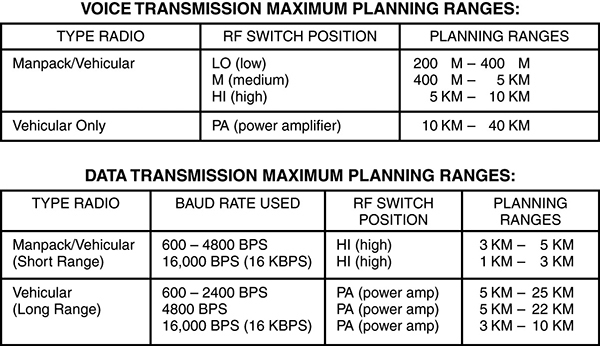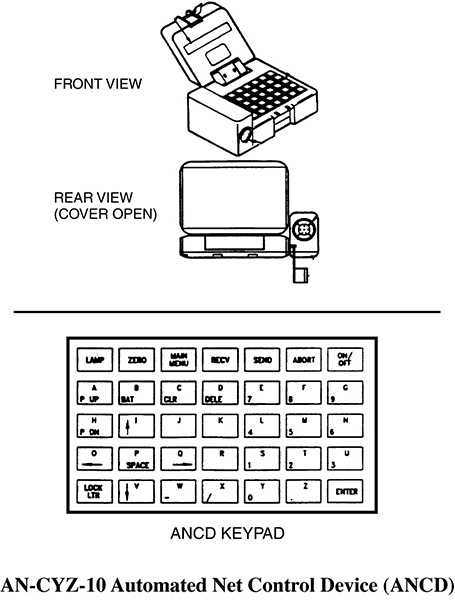

Loading Frequencies
The procedure for loading single channel (SC) frequencies requires setting the proper switches, pressing the correct number keys for the frequency you wish to load, and storing the load in RT permanent memory by pressing the STO (storage) button. Loading secure frequencies requires special COMSEC devices that transmit the proper “FILL” data to the radio, including frequencies, FH data, secure transmission data, and other necessary information. The current device is called an AN/CYZ-10. The AN/CYZ-10 automated net control device (ANCD) is a handheld device capable of receiving, storing, and transferring data between ANCDs, or between ANCD and a SINCGARS or ASIP radio. The primary application for this device is to fill the ASIP with FH data, time, communications security (COMSEC), and loadset information. Correct operating instructions may be obtained from various technical manuals and the unit signal officer.
Key Operator Tasks
Many tasks are needed to become completely proficient with the SINCGARS and they would fill a good portion of this guide. However, two important and basic operator tasks follow:
1.
Select RT Preparation Settings from MENU.
The tasks listed below are necessary to get the radio in operation.
a.
Set RT Volume
1.
Press MENU
Press MENU to display VOL level
2.
Press Digit (1–9) for VOL
Display reads WHSP if 0 selected
Setting (0) for Whisper Mode
b.
Set RT Channel
1.
Press MENU
(until CHAN)
Display reads (1–6), (Q) for CUE, (M) for Manual
2.
Press Digit (1–6) for Channel desired: (0) for MAN, (7) for CUE
c.
Set RT Power
1.
Press MENU (until PWR)
Display reads (LO, M, HI, PA)
2.
Press CHG for desired PWR setting
d.
Set RT Mode
1.
Press MENU (until MODE)
Display reads (SC, FH, FHM)
2.
Press CHG for desired MODE
e.
Set COMSEC
1.
Press MENU (until CMSC)
Display reads (PT, CT, TD, RV)
2.
Press CHG for desired CMSC setting
f.
Set Backlight
1.
Place RT in SQ ON
Backlight lights (4 settings Low to High, then OFF)
2.
Press FREQ/Backlight
3.
Press CHG until desired setting
Default settings are: VOL (5), CHAN (1), PWR (LO), MODE (FH), COMSEC (CT).
2.
Load Single-Channel (SC) Frequency into ASIP Radio.
The ASIP operator is required to perform this task in preparation for the employment of single channel communications, use of the CUE (key the radio), and ERF (electronic remote fill) methods of late net entry, and for single channel frequency updates. The operator determines the required frequencies from the ANCD or another source. These frequencies are then loaded into the radio by use of the receiver-transmitter (RT) keyboard. The steps are:
a.
Prepare to perform task
1.
Obtain proper freq from ANCD
(Load CUE freq only if directed)*
b.
Load SC freq
2.
Set RT controls:**
RT display shows “GOOD”
COMSEC to PT
(or see unit maintainer)
Mode to SC
FCTN to Z-FH, TST, and then to LD
CHAN to MAN, CUE, or 1–6
c.
Store SC freq
1.
Press: [FREQ]
Display shows [00000] or [30000]
2.
Press: [CLR]
Display shows [_____]
3.
Enter 5-digits SC freq
Display shows SC [XXXXX]
d.
Prepare to communicate
Press STO (within 7 sec)
Display blinks once (data is stored)
e.
Set COMSEC
1.
Repeat: Step b-1 for each freq needed
(As directed by NCS or unit SOP)
2.
Set: FCTN to SQ ON complete
Loading of SC freq is complete
*Only NCS and Alt NCS will load a CUE frequency.
**RT settings for ASIP are set via MENU.
FIELD EXPEDIENT ANTENNAS
Expedient antennas are temporary antennas designed and constructed by the user to increase the range of tactical radio sets. Antennas that are components of tactical radio sets are, for the most part, vertical antennas, resulting in the signal radiating equally in all directions. Expedient antennas increase the operating range of a given radio set, providing increased efficiency through the use of an antenna specifically designed for the operating frequency in use, elevation of the antenna above the ground, or concentration of the radiated signal along a given direction. Field expedient antennas are easily constructed from field wire using poles or trees for support. Whatever antenna is used, remember that the most important considerations are site location and the radio set location. Before deciding to construct a field expedient antenna, other considerations or operating hints that may improve communications are as follows:
•Use a headset to receive weak signals.
•Speak slowly and distinctly, directly into the microphone or handset.
•Use an RC-292 antenna, if available.
•Use continuous wave (CW) in place of voice for increased range on AM radios.
Steel wires should be clipped off, leaving only the copper wires. The copper wires are twisted together and placed into the center hole of the auxiliary antenna connector or the antenna connector. Make sure the wires do not touch any other part of the radio set.
If the whip antenna of your radio becomes damaged, try a piece of communication wire tied to a broomstick or a tree limb. Insert the end of the wire in the antenna connector. If you hold the stick or limb in a vertical position, you should be able to communicate. It will not be as effective as with the whip antenna, but it is better than no antenna at all.
Vertical Antennas
Vertical field expedient antennas improve radio set performance by virtue of height above the ground. The most effective height above the ground is equal to one-half the wavelength of the operating frequency in meters. Elevation above this height requires ground plane elements.
Improvised Whip Antenna. Whip antennas may break during use, with no replacement readily available. If this should happen, it is possible to improvise a satisfactory replacement by using telephone cable WD-1/TT or lashing the broken antenna pieces together.
Patrol Antenna. The patrol antenna is used primarily with FM radios. It can be used extensively in heavily wooded areas with the portable radio sets to increase line-of-sight communications. Antenna performance increases with height above the ground up to 13 meters.